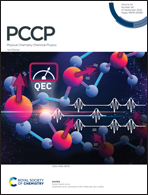Insights into non-thermal plasma chemistry of acetone diluted in N2/O2 mixtures: a real-time MS experiment†
Abstract
Understanding non-thermal plasma reactivity is a complicated task as many reactions take place due to a large energy spectrum. In this work, we used a well-defined photo-triggered non-filamentous discharge to study acetone decomposition in N2/O2 gas mixtures. The plasma reactor is associated to a compact chemical ionization FTICR mass spectrometer (BTrap) in order to identify and quantify in real-time acetone and by-products in the plasma. Presence of oxygen (1 to 5%) decreased notably acetone degradation. A tremendous change is observed in the by-products distribution concomitantly to a global decrease of their total concentration. While main products observed in oxygen-free gas mix are nitrile compounds, in oxygenated media they are replaced by formaldehyde, methanol and ketene. Methanol is maximum for 1% of O2 whereas formaldehyde and ketene concentration reach their maximum value at the highest oxygen concentration tested (5%). A number of nitrate, nitrite and isocyanate organic compounds (C1 and C2) are observed as well with HNO2, HNO3 and HNCO.



 Please wait while we load your content...
Please wait while we load your content...